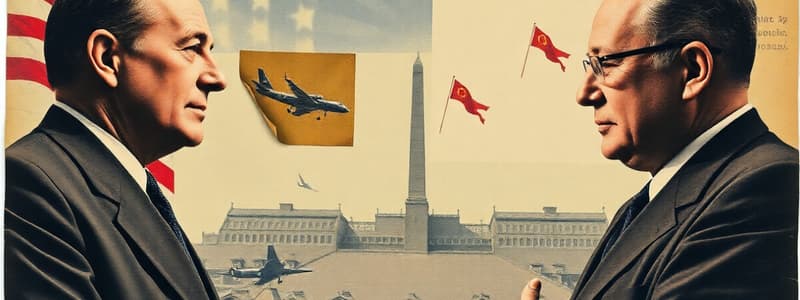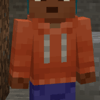Podcast
Questions and Answers
Which of the following factors contributed to the rise of consumerism in the 1950s and 1960s?
Which of the following factors contributed to the rise of consumerism in the 1950s and 1960s?
- Low unemployment and steady economic growth. (correct)
- Decline in suburban living and reduced access to credit.
- Widespread nationalization of industries.
- Increased taxes and government regulations.
The Iron Curtain was a physical barrier made of concrete and barbed wire that divided Western and Eastern Europe.
The Iron Curtain was a physical barrier made of concrete and barbed wire that divided Western and Eastern Europe.
False (B)
What was the main goal of the Truman Doctrine?
What was the main goal of the Truman Doctrine?
containment
The migration of white people from cities to suburbs is known as '______ flight'.
The migration of white people from cities to suburbs is known as '______ flight'.
If the Korean War ended in an armistice (ceasefire) with no clear victory for either side, what outcome aligns with the original foreign policy aims of the United States?
If the Korean War ended in an armistice (ceasefire) with no clear victory for either side, what outcome aligns with the original foreign policy aims of the United States?
Which policy did the British Prime Minister employ in the 1930s towards Hitler's expansionist policies in an attempt to prevent another war?
Which policy did the British Prime Minister employ in the 1930s towards Hitler's expansionist policies in an attempt to prevent another war?
Prior to World War II, relations between Japan and the United States were strained due to Japan's policy of economic cooperation with the United States.
Prior to World War II, relations between Japan and the United States were strained due to Japan's policy of economic cooperation with the United States.
What project was responsible for the research and development that led to the creation of nuclear weapons during WWII?
What project was responsible for the research and development that led to the creation of nuclear weapons during WWII?
The surprise attack by Germany that resulted in significant casualties and a notable 'bulge' in the map of Belgium is known as the Battle of the ______.
The surprise attack by Germany that resulted in significant casualties and a notable 'bulge' in the map of Belgium is known as the Battle of the ______.
Match the WWII leaders with their respective countries:
Match the WWII leaders with their respective countries:
Which of the following best describes eugenics?
Which of the following best describes eugenics?
What was the codename for the Allied amphibious invasion of Normandy, France, a critical turning point in WWII?
What was the codename for the Allied amphibious invasion of Normandy, France, a critical turning point in WWII?
What geographic objectives beyond Okinawa did the US military have planned before the end of WWII, aiming to bring about Japan's ultimate surrender, which were never executed due to the dropping of the atomic bombs?
What geographic objectives beyond Okinawa did the US military have planned before the end of WWII, aiming to bring about Japan's ultimate surrender, which were never executed due to the dropping of the atomic bombs?
Flashcards
1950s Economic Boom
1950s Economic Boom
Post-WWII trend: Increased spending, suburban growth, high employment, and economic prosperity.
GI Bill
GI Bill
Law providing benefits like education and home loans to WWII veterans.
"White Flight"
"White Flight"
The departure of white residents from cities to suburbs.
Containment
Containment
Signup and view all the flashcards
NATO
NATO
Signup and view all the flashcards
Appeasement
Appeasement
Signup and view all the flashcards
Internment Camps
Internment Camps
Signup and view all the flashcards
Anti-Semitism
Anti-Semitism
Signup and view all the flashcards
Genocide
Genocide
Signup and view all the flashcards
Eugenics
Eugenics
Signup and view all the flashcards
Stalingrad
Stalingrad
Signup and view all the flashcards
D-Day
D-Day
Signup and view all the flashcards
Manhattan Project
Manhattan Project
Signup and view all the flashcards
Study Notes
- Appeasement means giving into something.
- In the 1930s, the British Prime Minister appeased Hitler's expansionist policies.
- The goal of the appeasement was to avoid another war, especially after World War I.
Japanese / American Relations Prior to WWII
- Prior to World War II, relations between Japan and America were positive.
- The U.S. started blocking trade with Japan as it used military power for expansion.
Internment Camps
- The U.S. sent people of Japanese descent to internment camps because they were suspected of being criminals or enemy sympathizers.
- The camps had poor living conditions, health, education, and high security.
Events That Initiated WWII
- Nazi invasions (Poland & USSR).
- Attack on Pearl Harbor.
Figures in WWII
- Franklin D. Roosevelt was the 32nd U.S. President, from 1933-1945.
- Stalin led the USSR from 1924-1953.
- Hitler was the dictator of Nazi Germany from 1933-1945.
Pearl Harbor
- Pearl Harbor is located in Hawaii.
- Japan launched a surprise attack on Pearl Harbor.
- This attack led to the entry of the U.S. into World War II.
Genocide
- Genocide is the deliberate killing of a large number of people from a particular nation or ethnic group.
- The aim of genocide is destroying that nation or group.
Anti-Semitism
- Anti-Semitism is prejudice or hatred against Jews.
Eugenics
- Eugenics is a pseudoscience.
- Eugenics states some people are born genetically superior and others genetically inferior.
Hitler’s Rise to Power
- Hitler caught public attention with his manipulative public speaking.
- Germany was in horrible economic conditions because of the Treaty of Versailles.
- Germans were humiliated.
- He blamed Germany’s problems on Jews.
Stalingrad
- Stalingrad was a battle between Germany and the USSR.
- It was the most bloody battle.
- The battle changed the tides of the war.
- It ended with the capture of Berlin.
- The USSR won.
D-Day
- D-Day was the Allied invasion of Normandy, France.
- It was an amphibious attack.
- Thousands died by the end of the day.
Battle of the Bulge
- The Battle of the Bulge as a surprise attack by Germany.
- It led to many deaths and an apparent “bulge” in Belgium.
Iwo Jima
- U.S. Marines took control of the island of Iwo Jima.
- This led the way for largest battle in the pacific- battle of Okinawa.
Okinawa
- Okinawa was the last major battle of World War II.
- It was a plan to invade and occupy the Ryukyu islands of Japan.
- The U.S. won, but there were large death tolls on each side.
Use of the Atomic Bomb
- The U.S. dropped 2 atomic bombs on Hiroshima & Nagasaki.
- This bombing resulted in many civilian deaths and long-term health effects.
- It caused Japan to surrender in World War II.
Manhattan Project
- The Manhattan Project involved research & development during World War II.
- The goal was to create nuclear weapons.
The Allies
- The Allies were the U.S., France, Great Britain, & USSR.
The Axis Powers
- The Axis Powers were Italy, Nazi Germany, and Japan.
Post War Economic Growth
- It was spurred by the removal of trade tariffs and growing consumer demand.
- There was a rise in consumerism and large-scale moves to suburbs.
- The country experienced low unemployment and steady economic growth.
Role of the TV in 1950s/1960s Culture
- TV showed a glorified life of what it was like to live in the 50s.
- TV portrayed a stereotypical life for women cooking & cleaning & staying at home.
- Many groups were excluded.
The GI Bill
- This law provided many benefits for World War II vets.
“White Flight”
- This was the migration of white people from cities to suburbs.
Capitalism
- It is an economic system.
- Goods & services are privately owned for the means of obtaining a profit.
Communism
- It is a political & economic system.
- It aims to control an equal society.
- The government controls resources.
- Wealth is shared equally.
The Iron Curtain
- This is a metaphor.
- It describes the division of western & eastern Europe.
- It also refers to their division of communism & capitalism.
- Western Europe: capitalism.
- Eastern Europe: communism.
Containment
- This was the U.S. policy to stop the spread of communism.
Warsaw/NATO
- NATO is an alliance of the U.S., Canada, & many European countries.
- The Warsaw Pact was formed after NATO by the USSR & other Soviet satellite nations.
HUAC
- It was created to investigate people suspected of being or having communist ties.
Truman Doctrine
- This policy states America will help defend democratic nations against communist threats.
- It further helps the goal of containment.
The Korean War
- North Korea was occupied by the USSR
- South Korea was occupied by the USA
- North Korea invaded South Korea
- The USSR helped North Korea
- The USA helped South Korea
- It ended with an armistice.
- This means neither side wins or loses.
Joseph McCarthy
- Joseph McCarthy was a Senator.
- He made claims of communist spies being in the U.S. government.
John F. Kennedy
- John F. Kennedy was the 35th president.
- Served 1961-1963.
- He was assassinated in 1963.
Nikita Khrushchev
- Nikita Khrushchev was the leader of USSR during 50s through early 60s.
Studying That Suits You
Use AI to generate personalized quizzes and flashcards to suit your learning preferences.





